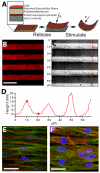Biohybrid thin films for measuring contractility in engineered cardiovascular muscle
- PMID: 20149449
- PMCID: PMC2838170
- DOI: 10.1016/j.biomaterials.2010.01.079
Biohybrid thin films for measuring contractility in engineered cardiovascular muscle
Abstract
In vitro cardiovascular disease models need to recapitulate tissue-scale function in order to provide in vivo relevance. We have developed a new method for measuring the contractility of engineered cardiovascular smooth and striated muscle in vitro during electrical and pharmacological stimulation. We present a growth theory-based finite elasticity analysis for calculating the contractile stresses of a 2D anisotropic muscle tissue cultured on a flexible synthetic polymer thin film. Cardiac muscle engineered with neonatal rat ventricular myocytes and paced at 0.5 Hz generated stresses of 9.2 +/- 3.5 kPa at peak systole, similar to measurements of the contractility of papillary muscle from adult rats. Vascular tissue engineered with human umbilical arterial smooth muscle cells maintained a basal contractile tone of 13.1 +/- 2.1 kPa and generated another 5.1 +/- 0.8 kPa when stimulated with endothelin-1. These data suggest that this method may be useful in assessing the efficacy and safety of pharmacological agents on cardiovascular tissue.
Copyright 2010 Elsevier Ltd. All rights reserved.
Figures






Similar articles
-
Toward improved myocardial maturity in an organ-on-chip platform with immature cardiac myocytes.Exp Biol Med (Maywood). 2017 Nov;242(17):1643-1656. doi: 10.1177/1535370217701006. Epub 2017 Mar 26. Exp Biol Med (Maywood). 2017. PMID: 28343439 Free PMC article.
-
Muscular thin films for building actuators and powering devices.Science. 2007 Sep 7;317(5843):1366-70. doi: 10.1126/science.1146885. Science. 2007. PMID: 17823347
-
Controlling the contractile strength of engineered cardiac muscle by hierarchal tissue architecture.Biomaterials. 2012 Aug;33(23):5732-41. doi: 10.1016/j.biomaterials.2012.04.043. Epub 2012 May 15. Biomaterials. 2012. PMID: 22594976 Free PMC article.
-
Ensembles of engineered cardiac tissues for physiological and pharmacological study: heart on a chip.Lab Chip. 2011 Dec 21;11(24):4165-73. doi: 10.1039/c1lc20557a. Epub 2011 Nov 10. Lab Chip. 2011. PMID: 22072288 Free PMC article.
-
Muscle on a chip: in vitro contractility assays for smooth and striated muscle.J Pharmacol Toxicol Methods. 2012 May-Jun;65(3):126-35. doi: 10.1016/j.vascn.2012.04.001. Epub 2012 Apr 12. J Pharmacol Toxicol Methods. 2012. PMID: 22521339 Free PMC article.
Cited by
-
Cardiac Tissues From Stem Cells: New Routes to Maturation and Cardiac Regeneration.Circ Res. 2021 Mar 19;128(6):775-801. doi: 10.1161/CIRCRESAHA.121.318183. Epub 2021 Mar 18. Circ Res. 2021. PMID: 33734815 Free PMC article. Review.
-
Extracellular Vesicles in Cardiac Regeneration: Potential Applications for Tissues-on-a-Chip.Trends Biotechnol. 2021 Aug;39(8):755-773. doi: 10.1016/j.tibtech.2020.08.005. Epub 2020 Sep 19. Trends Biotechnol. 2021. PMID: 32958383 Free PMC article. Review.
-
Toward improved myocardial maturity in an organ-on-chip platform with immature cardiac myocytes.Exp Biol Med (Maywood). 2017 Nov;242(17):1643-1656. doi: 10.1177/1535370217701006. Epub 2017 Mar 26. Exp Biol Med (Maywood). 2017. PMID: 28343439 Free PMC article.
-
Empirically Determined Vascular Smooth Muscle Cell Mechano-Adaptation Law.J Biomech Eng. 2017 Jul 1;139(7):0710051-9. doi: 10.1115/1.4036454. J Biomech Eng. 2017. PMID: 28418526 Free PMC article.
-
Recreating the Cardiac Microenvironment in Pluripotent Stem Cell Models of Human Physiology and Disease.Trends Cell Biol. 2017 May;27(5):352-364. doi: 10.1016/j.tcb.2016.11.010. Epub 2016 Dec 19. Trends Cell Biol. 2017. PMID: 28007424 Free PMC article. Review.
References
-
- Rohr S, Scholly DM, Kleber AG. Patterned growth of neonatal rat heart cells in culture. Morphological and electrophysiological characterization. Circ Res. 1991;68:114–30. - PubMed
-
- Gillis AM, Fast VG, Rohr S, Kleber AG. Spatial changes in transmembrane potential during extracellular electrical shocks in cultured monolayers of neonatal rat ventricular myocytes. Circ Res. 1996;79:676–90. - PubMed
-
- Bursac N, Parker KK, Iravanian S, Tung L. Cardiomyocyte cultures with controlled macroscopic anisotropy - A model for functional electrophysiological studies of cardiac muscle. Circ Res. 2002;91:E45–E54. - PubMed
-
- Entcheva E, Bien H, Yin LH, Chung CY, Farrell M, Kostov Y. Functional cardiac cell constructs on cellulose-based scaffolding. Biomaterials. 2004;25:5753–62. - PubMed
Publication types
MeSH terms
Substances
Grants and funding
LinkOut - more resources
Full Text Sources
Other Literature Sources

